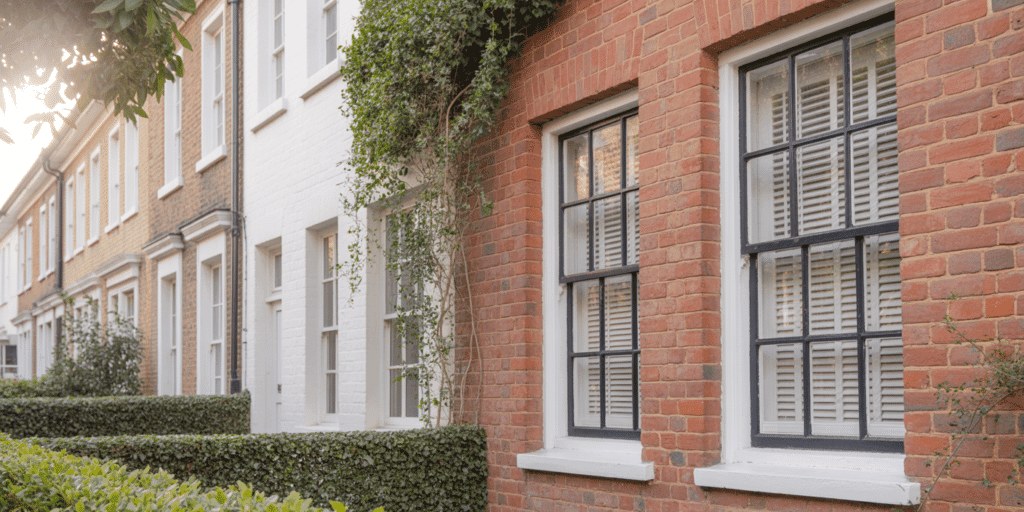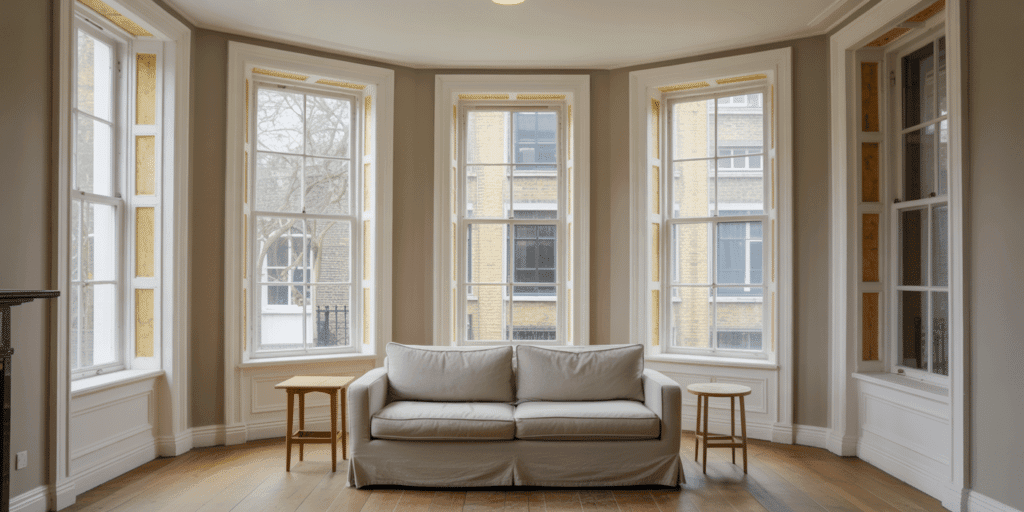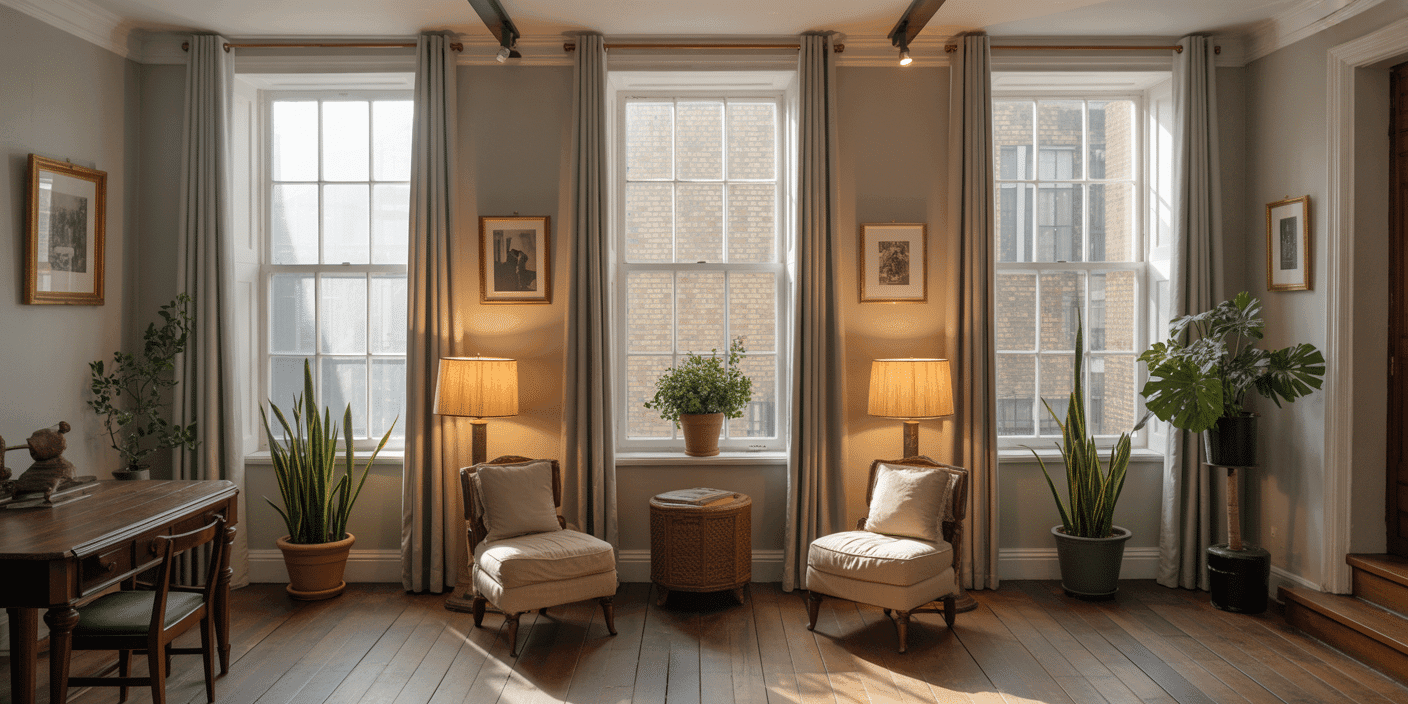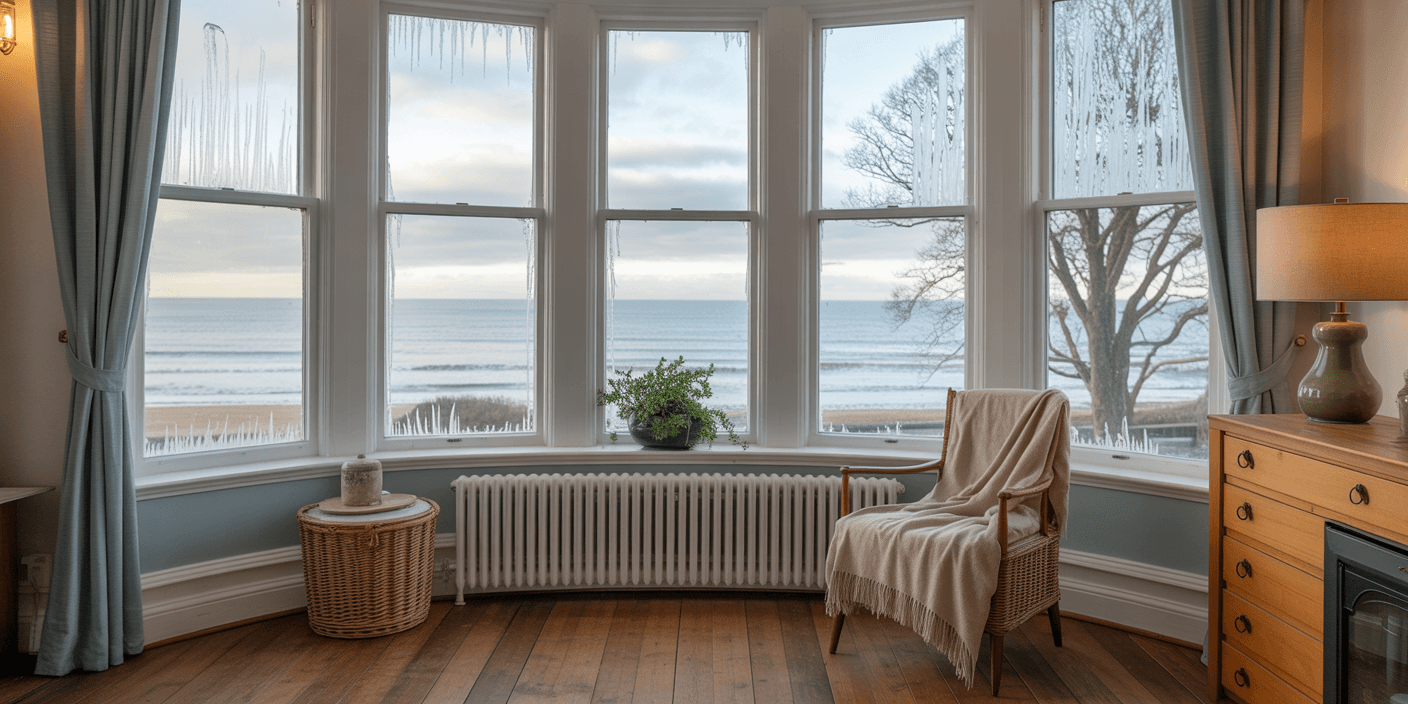The Invisible Leak
“Your Home Could Be Bleeding Energy—Without a Sound.”
There is a silent departure happening in thousands of homes across Britain.
It doesn’t creak on staircases, rattle windows, or trigger alarms.
It moves invisibly—slipping past underperforming glazing, drifting through ageing timber frames, and vanishing into the cold London sky.
It’s heat. And in most homes, it’s leaving far faster than it should.
While many homeowners invest confidently in boilers, insulation, or smart thermostats, few consider that up to 30% of heat loss occurs through glazing. This is not a fringe inefficiency—it’s an architectural blind spot. For period properties and pre-2000 builds, it represents a steady erosion of comfort, cost-efficiency, and carbon intent.
Even the most charming heritage sash windows, if left unrefined, may be quietly undoing every other effort made toward thermal stability.
But this is not solely a question of temperature.
This is about equilibrium.
The absence of draught.
The stillness of a perfectly sealed room on a winter morning.
The assurance that behind every pane is a silent, finely engineered barrier—not just against cold, but against loss itself.
True energy performance is not an abstract metric. It is the tangible feeling of retained warmth, reduced noise, and restful consistency.
And at the centre of this lies a principle often misunderstood, yet profoundly consequential: the U-value.
Let’s begin with what it is, what it isn’t, and why mastering it is the foundation of any intelligent window specification.
Understanding U-Value: The Cold Truth About Warmth
“The Colder the Number, the Warmer the Home.”
Imagine standing beside two identical windows on a bitter January morning. One feels… neutral. The other sends a faint chill radiating across the room.
They look the same. They cost nearly the same.
But one is quietly, consistently robbing your comfort.
That’s the difference a U-value makes.
So, What Is U-Value?
In simple terms, U-value measures how well a window prevents heat from escaping. It’s expressed in watts per square metre per degree kelvin:
W/m²K.
Ignore the unit. Focus on the number.
The lower the U-value, the better your window performs.
- Single-glazed windows (common pre-1980s): U-value of 4.8–5.8
- Older double-glazing: U-value around 2.7–3.0
- Modern double-glazing: 1.4–1.6
- Triple-glazing (like ours): as low as 0.8 — a near-passive standard
This isn’t a marginal improvement. It’s a total transformation in thermal integrity.
What Does That Actually Mean?
Let’s dispense with theory.
If your living room has 10 square metres of glazing at a U-value of 2.8, you’re losing 280 watts of heat per degree of temperature difference between inside and outside.
If it’s 5°C outside and 20°C inside — that’s 4.2 kilowatts of heat leaking out per hour. Constantly.
Now swap that window system for one rated 1.0 W/m²K. Your losses drop to just 1.5 kW/hour.
That’s the difference between a draughty room and an always-comfortable one.
And it’s also the difference between spiralling bills and silent savings.
Whole-Window vs. Centre-of-Glass
Beware the marketing sleight of hand.
Some firms quote only centre-of-glass U-values — which omit the losses from spacer bars, frames, seals and installation.
At Sash Windows London, we always speak in whole-unit U-values — because that’s what actually impacts your home.
When every detail matters — from frame choice to edge seal to thermal break — partial truths aren’t just misleading; they’re wasteful.
U-Value and Frame Material
The frame carries nearly 30% of the thermal load of a window system. That means your glazing can be outstanding, but if the frame is a poor conductor — or worse, metal without a thermal break — you’ve still got a heat leak.
This is why we design with high-performance timber, alu-clad, and composite systems — combining heritage beauty with passive-ready insulation.
And it’s also why we custom-calibrate every installation to its orientation, elevation, and use case.
Why U-Value Alone Isn’t Enough
U-value tells you what the window keeps in. But there’s another metric — SHGC — that tells you what it lets in.
We’ll explore that next. But remember this:
A lower U-value isn’t a gimmick or upsell.
It’s the quiet difference between “almost warm enough” and “I never thought it could feel this good.”
SHGC: The Sunshine Equation No One Talks About

“The Heat You Want—and the Heat You Don’t.”
If U-value is about keeping warmth in, then SHGC is about managing the sun’s energy —
deciding what comes in and how much.
This is the part most homeowners (and far too many builders) overlook.
And yet it can determine whether your sitting room feels calm and cosseted… or like a south-facing greenhouse by mid-July.
What is SHGC?
SHGC stands for Solar Heat Gain Coefficient.
It measures how much solar radiation a window allows through — from 0 (none) to 1 (all).
In human terms:
- A high SHGC window lets in more heat from sunlight — great in winter, problematic in summer.
- A low SHGC window filters that energy — keeping your interior stable, your blinds drawn less often, and your cooling bills in check.
Why It Matters in the UK
In Britain, the climate is less extreme than in Dubai or Dallas — but the balance between insulation and passive solar gain is still critical.
- A north-facing room in Edinburgh may benefit from higher SHGC glazing — harvesting warmth when it’s available.
- A south-facing living space in London may need a lower SHGC to prevent overheating in late summer.
- A loft conversion with roof lights will behave entirely differently from a shaded Victorian bay window.
That’s why SHGC can’t be specified in isolation.
It must be tailored to orientation, room function, and architectural envelope — precisely what Sash Windows London accounts for when designing your system.
It’s About Control — Not Just Glass
Advanced glazing systems use a combination of:
- Low-E coatings (invisible layers that reflect heat)
- Tinted or spectrally selective coatings
- Argon or krypton gas fills
- Triple-glazing with asymmetrical panes (each layer tuned differently)
This isn’t just technology for its own sake.
It’s what allows your home to feel the same in July as it does in February — no matter what the weather decides.
Overheating: The Hidden Modern Risk
Ironically, many energy-conscious homeowners end up creating accidental hotboxes.
They install super-insulated windows with high SHGC glazing— then wonder why the house becomes unbearable in the evenings.
This is especially common in loft spaces, modern extensions, and homes with open-plan glazing facing the sun.
Precision matters. SHGC is not one-size-fits-all.
What We Do Differently
At Sash Windows London, we don’t pick glazing units from a catalogue.
We specify every project based on solar orientation, room function, planning constraints, and lifestyle rhythms.
We consider:
- Which rooms you use in the morning vs. evening
- How much direct sun does your façade absorb
- Whether you value light more than passive heat
- Whether you’re in a conservation area or a new build
Because the best insulation isn’t just about blocking out the cold.
It’s about letting in the right warmth, in the right way, at the right time.
The Frame Is the Forgotten Hero
“You Can’t Have an Efficient Window in an Inefficient Frame.”
Talk to most window salespeople and they’ll sell you on the glass.
Triple this. Laminated that. U-values are low enough to keep a greenhouse warm in Greenland.
But here’s the truth:
Up to 30% of a window’s thermal performance depends on the frame.
And if it’s not specified correctly—if it’s made from the wrong material, or installed without proper thermal breaks—then even the best glazing system will underperform.
It’s like wrapping a fine bottle of wine in tin foil and expecting the temperature to stay stable.
Thermal Bridges: Where Comfort Escapes
Frames without thermal separation become conduction highways.
Heat passes through them effortlessly—especially in metal frames.
In fact, aluminium windows without thermal breaks can act like radiators in reverse: sucking heat from the room and funnelling it outside.
The glass might boast an exceptional U-value… but the overall unit fails, because the cold is creeping in from the sides.
This is why whole-window U-value (frame + spacer + glass) matters more than any single part.
Comparing Frame Materials: Beauty vs. Performance?
Let’s break it down:
- uPVC: Affordable, low maintenance, but often lacks the heritage appearance or rigidity desired in higher-end homes. Good insulation, but limited lifespan.
- Aluminium: Sleek, strong, minimal sightlines—but a natural conductor of heat. Must include thermal breaks to be viable.
- Timber: Warm, breathable, inherently insulative. Ideal for period homes. Requires maintenance but offers unmatched authenticity.
- Alu-Clad/Composite: Timber core with aluminium shell. The best of both worlds — beauty, performance, longevity, and low maintenance.
This last category — alu-clad timber — is where many of our most discerning clients end up. It meets the eye test, passes conservation rules, and exceeds thermal expectations.
What About Heritage Homes?
Here’s where Sash Windows London shines.
We’re often asked to design high-performance window systems for listed buildings or conservation areas, where modern frames are typically banned.
Our solution? Engineered timber systems with discreetly integrated thermal enhancements.
- Slim sightlines
- Traditional mouldings
- But under the surface: high-performance seals, laminated Low-E glass, and insulated spacer bars.
It’s how we preserve the past without sacrificing the present.
Frame Performance in Real Terms
Let’s say you’ve upgraded your glass to a U-value of 0.8 — but your aluminium frame has no thermal break.
Your overall window performance could be closer to 1.6–1.8 — nearly double the intended loss.
That’s not just a technicality. It’s a real-world effect:
- Cooler air near windows
- Higher heating demand
- Greater condensation risk
- Perceived “draughtiness” — even when the seals are intact
That’s why we never treat the frame as an afterthought.
For us, it’s part of the architecture.
Framing the Experience
A well-crafted window frame does more than hold glass.
It holds:
- Warmth, by eliminating conduction gaps
- Silence, by dampening vibration and sealing shut
- Security, by housing multi-point locking mechanisms
- Legacy, by harmonising with the building’s design language
This is where the artistry meets the engineering.
And this is where Sash Windows London refuses to compromise—
Because a frame isn’t just a structure. It’s a statement.
Airtightness, Soundproofing, and the Science of Stillness
“When the World Outside Goes Quiet, You’ll Know It’s Working.”
You won’t hear airtightness working. That’s the point.
There’s no sound when a seal closes perfectly.
No draft rustling your curtains.
No bus engine muttering through double glazing.
Just a room that holds its temperature—and its silence.
This isn’t just energy efficiency. It’s environmental control. And it’s what separates “new windows” from precision-engineered comfort systems.
Why Airtightness Matters
Most people focus on glass and frame performance. But the most common point of failure isn’t in the window itself—it’s in the gaps around it.
Improper installation, subpar sealing, warped sashes, or poorly fitted trickle vents can:
- Let in cold air
- Let out warmth
- Invite external noise
- Undermine U-value gains achieved by good glazing
What you end up with is a technically upgraded window that still feels like the old one.
Draughty. Noisy. Inconsistent.
That’s not installation—it’s a missed opportunity.
The Science Behind the Stillness
True airtightness is a fusion of:
- High-precision manufacturing (for sash-to-frame fit)
- Multi-stage perimeter sealing systems
- Intelligent venting (to allow airflow without thermal loss)
- Moisture and vapour control membranes behind the scenes
At Sash Windows London, we test, measure, and seal with passive-house-level rigour—even in heritage properties.
Our approach ensures that once the sash is closed, the room stabilises—in temperature, in acoustics, in air pressure.
It becomes a zone of stillness, no matter the noise or weather outside.
Silence is a Signal
Many of our clients say the same thing after installation:
“I didn’t realise how loud my street was until it suddenly wasn’t.”
Triple glazing with asymmetric laminated glass and gas-filled cavities can reduce noise by up to 45 decibels.
But it only works if the frame and seals are equally tuned.
Otherwise, noise simply slips around the edges.
This is particularly vital for:
- Urban homes near roads, rail, or flight paths
- Victorian terraces with paper-thin separation walls
- Bedrooms and studies where quiet is not a luxury, but a necessity
Thermal comfort is measurable.
Acoustic comfort is experiential.
Both matter.
The Illusion of “New Windows”
Some homeowners believe airtightness is a given with modern glazing.
But many off-the-shelf systems prioritise ease of manufacture over precision of fit.
Seals are generic. Frames are slightly oversized. Installation is rushed.
The result? A window that looks modern, but feels hollow—physically and psychologically.
At Sash Windows London, our sealing tolerances are engineered to <1.5mm variation.
We account for timber movement.
We seal in phases.
We revisit sites for post-install tuning.
Because perfection isn’t declared on day one.
It’s felt over the next ten winters.
Stillness is the New Luxury
In an age of notifications, roadworks, and construction, true stillness has become a form of wealth.
The kind that can’t be bought in a product catalogue.
The kind that’s installed in silence—and recognised the moment it’s missed.
When your home becomes a sanctuary of quiet, stability and warmth, that’s not a coincidence.
That’s the intention in every joint, seal, and specification.
That’s what we do.
Beyond Compliance: Mastering Part L, Part Q, and Part K

“Building Regulations Aren’t Bureaucracy. They’re Blueprints for Better Living.”
Let’s be honest.
Most homeowners see building regulations as obstacles.
Boxes to tick. Hurdles to clear. Necessary annoyances, at best.
But what if we saw them differently?
Not as constraints, but as codified standards of care.
Not minimums, but minimum guarantees that your home is safe, secure, and sustainable.
The truth is, mastering regulation is not a limitation—it’s liberation.
It means you can build boldly, beautifully, and confidently—without compromise.
And it’s where Sash Windows London quietly excels.
What Are These Parts, Anyway?
Let’s decode the trinity of performance regulation that governs every window installation in the UK:
Part L – Conservation of Fuel and Power
- Focus: Thermal efficiency
- Requires windows to meet minimum U-value standards
- Integral to reducing heat loss and cutting carbon emissions
- Implication: Your glazing isn’t compliant unless it genuinely insulates
Part Q – Security in Dwellings
- Focus: Protection from unauthorised entry
- Applies to new dwellings and certain extensions
- Requires PAS 24-rated hardware, locks, and glazing
- Implication: Your windows must not only look right, but also defend right
Part K – Protection from Falling, Collision & Impact
- Focus: Safety of glass placement and strength
- Governs where toughened or laminated glass is required (e.g., below 800mm from floor level)
- Implication: Your design vision must still protect the people inside
These aren’t abstract rules. They’re there to ensure your home isn’t just beautiful—but built to last, protect, and perform.
Sash Windows London: Where Craft Meets Code
We don’t chase compliance.
We design with it baked in from the start.
That means:
- All glazing systems we recommend exceed Part L thermal thresholds
- Our locking systems and laminated glass options are PAS 24 ready for Part Q security
- We conduct site-specific risk assessments to meet Part K safety at every threshold and floor
We don’t retrofit compliance. We engineer it in—quietly, confidently, and without disrupting your design intent.
Why This Matters for You
✅ It means fewer delays during planning and inspection
✅ It ensures resale confidence, especially for high-value London homes
✅ It protects your investment—in both design and function
✅ It keeps your contractor, architect, and building control officer aligned
✅ It allows you to focus on aesthetics, while we handle the intricacies
And for heritage or conservation homes?
We speak fluent “planners’ logic.”
We know how to mirror the past while insulating for the future—preserving appearances while enhancing performance.
Regulation as Reputation
Meeting Part L, Q, and K isn’t just about staying out of trouble.
It’s about standing behind every window system with engineering dignity.
Whether you’re in Notting Hill or Clapham, Surrey or Sussex, performance is the new prestige.
And your windows are the handshake your home gives to every season, every visitor, every valuation.
The Return on Comfort: What Energy Efficiency Really Pays For
“Every Degree You Keep Is a Pound You Don’t Spend.”
Some upgrades are aesthetic. Others are structural.
But energy-efficient glazing does both — while paying you back, silently, for decades.
We’ve grown up thinking of windows as a cost centre. Something necessary. Functional.
What most people don’t realise is this:
Properly specified windows are a compounding financial asset.
Let’s break it down.
Every Degree Matters
When you upgrade your glazing to achieve a whole-unit U-value of 1.2 or below, you dramatically reduce the amount of energy needed to heat your home.
That reduction doesn’t just mean “lower bills.”
It means:
- A more predictable monthly outgo
- Greater stability in a volatile energy market
- A smaller carbon footprint (whether or not you own a heat pump)
- Less load on your heating system, meaning longer equipment lifespan
- And most importantly: a home that feels consistently good, all year round
If comfort were just about temperature, a jumper would do.
But true comfort is emotional: it’s stability, silence, and serenity that doesn’t waver with the weather.
Long-Term Gains That Aren’t Just Financial
Let’s say your new glazing saves £500–£900 per year in energy costs. Over a decade, that’s £5,000–£9,000 — without factoring in energy inflation.
But now zoom out further:
- That thermal stability improves EPC ratings
- Better EPCs increase property valuation and appeal to eco-conscious buyers
- Lower carbon homes attract government grants and incentives
- Reduced maintenance from high-performance frames lowers long-term repair costs
- And for the security-conscious, Part Q compliance can lower insurance premiums
So yes, you’re gaining warmth.
But you’re also gaining resale strength, lower running costs, future-proof compliance, and reputation.
Why Not All Windows Pay You Back
There are plenty of products on the market that look efficient but don’t deliver.
Here’s why:
- Quoting glass U-values, not whole-window performance
- Using poor-quality spacers or edge seals
- Installing with air gaps, ruining airtightness gains
- Skimping on the glazing unit specification for cost
- Failing to tailor SHGC and frame choice to room orientation
A £3,000 window that bleeds heat for 20 years costs you more than a £5,000 window that locks it in for good.
At Sash Windows London, every system is engineered for longevity, not just legality.
That’s the difference between installing something
…and investing in something.
It’s Not About Cost. It’s About Worth.
If you’re weighing a quote and wondering,
“Is this really worth it?”
Ask this instead:
“What’s the price of feeling the same in January as you do in May?”
“What’s it worth to never touch the thermostat again?”
“What’s the cost of losing comfort every night… for the next 15 years?”
This isn’t about upselling. It’s about uprighting.
Because when your home holds its climate like a second skin, you don’t just save money.
You save peace of mind.
Ready to Stop the Leaks? Here’s How to Begin
“No Sales Pressure. Just Precision, Peace of Mind, and a Plan Built for Your Home.”
You’ve read this far because something resonated.
Not just the science. Not just the numbers.
But the possibility of stillness, warmth, silence—delivered by windows that finally do what they should.
Maybe your sash windows are underperforming.
Maybe your new extension is overheating.
Maybe your architect left a thermal gap the size of a December gas bill.
Whatever the reason, now is the time to stop patching the symptoms and address the system.
The Next Step Is Simple: Specification Without Obligation
We offer something most companies don’t:
A Bespoke Window Performance Review, crafted around your actual home.
No templated recommendations. No recycled brochures.
Just a 1-to-1 consultation where we:
- Assess your home’s orientation, exposure, and thermal behaviour
- Discuss your goals (heritage, acoustic, thermal, planning)
- Analyse compliance requirements (Part L, Q, K, conservation)
- Design a glazing + frame solution that is elegant, compliant, and quietly exceptional
If it’s not right, you walk away.
If it is, we’ll show you how to make it happen—step by step.
We’ve done this for hundreds of homes across London and the South East—Grade II-listed townhouses, modernist remodels, and everything between.
Your Window Isn’t Just a Product. It’s a Threshold.
A threshold between outside and in.
Between comfort and compromise.
Between guesswork and craftsmanship.
We don’t sell glass.
We engineer environments.
We customise stillness.
If that sounds like the kind of experience you’ve been waiting for, we invite you to begin.
🎯 Start Here:
Book Your Bespoke Window Performance Review →
See what your home is losing—and how effortlessly it could stop.







